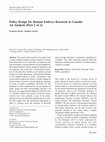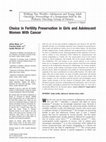Papers by Françoise Baylis
Intended audience: law school students; legal aid clinic staff; settlement and frontline workers

This article is the second in a two-part review of policy design for human embryo research in Can... more This article is the second in a two-part review of policy design for human embryo research in Canada. In the first article in 6(1) of the JBI, we explain how this area of research is circumscribed by law promulgated by the federal Parliament and by guidelines adopted by the Tri-Agencies, and we provide a chronological description of relevant policy initiatives and outcomes related to these two policy instruments, with particular attention to the repeated efforts at public consultation. This second article analyses the history of policy design for human embryo research in Canada, applying a typology of modes of public consultation developed by Eric Montpetit to better understand the various episodes of policy design and their corresponding outcomes. On this basis, we suggest that the degree to which the views of Canadian residents and citizens on human embryo research have been solicited as part of the policy-making process has diminished significantly over time. We also suggest that this diminished participation is likely to continue given the presence of powerful interest groups and policy communities " speaking for " Canadians. This raises interesting questions about the legitimacy of future policy initiatives for human embryo research in Canada.

Journal of Medical Ethics , 2010
International medical travel occurs when patients cross national borders to purchase medical good... more International medical travel occurs when patients cross national borders to purchase medical goods and services. On occasion, physicians in home countries will be the last point of domestic contact for patients seeking healthcare information before they travel abroad for care. When this is the case, physicians have a unique opportunity to inform patients about their options and help guide them towards ethical practices. This opportunity brings to the fore an important question: What role should physicians in
more-developed home countries play in promoting or constraining international medical travel towards less-developed destination countries? In our view, critical attention to the decision spaces of patients-defined by the personal circumstances, socio-cultural cues, and legal constraints that inform decision-making-is
a useful starting point for evaluating the proper response of physicians to various forms of international medical travel.
The Tri-Council Policy Statement: Ethical Conduct for Research Involving Humans (TCPS) was first ... more The Tri-Council Policy Statement: Ethical Conduct for Research Involving Humans (TCPS) was first issued in 1998. At that time, the inappropriate exclusion of women from clinical trials was a serious problem. Currently, the TCPS is undergoing a comprehensive review and it is expected that new research guidelines will be issued in 2010. One of the problems with the current draft of the revised TCPS is that it fails to properly address the routine exclusion of pregnant women from research. We illustrate the negative ethical implications of excluding pregnant women from research and argue for changes to the research guidelines that would address these negative implications.

[Opening paragraph]. Research ethics review committees commonly approve protocols that require wo... more [Opening paragraph]. Research ethics review committees commonly approve protocols that require women of childbearing potential to use one or two means of birth control while enrolled in clinical drug trials, and sometimes the means of birth control are specified (e.g., oral contraceptives or an intrauterine device). The purpose of a contraception requirement is to protect a developing fetus from exposure to drugs that might harm it by preventing pregnancy for the duration of the trial. Some commentators contend that it is ethically unacceptable to require women of childbearing potential to use contraception as a condition of trial participation because such a requirement violates women’s autonomy and is inconsistent with women’s well-being, as some forms of contraception carry health risks for women. These risks are all the more significant when contraceptive use is unnecessary, as when there is no risk of pregnancy. For others, mandated contraception for women of childbearing potential is ethically defensible on the grounds that while women might benefit from participating in clinical drug trials, they should not expose a potential fetus to drugs that could be harmful.
Feminist Review, 2004
ECE FE IS ADVANCES EDITED BY Anne Donchin AND Laura M. Purdy ... Embodying Bioethics This On< ... more ECE FE IS ADVANCES EDITED BY Anne Donchin AND Laura M. Purdy ... Embodying Bioethics This On< PBGU-SN7-F7HB ... New Feminist Perspectives Series Series Editor: Rosemarie Tong, Davidson College Claiming Reality: Phenomenology and Women's Experience by ...
A Constitutional Defence of the Federal Ban on Human Cloning for Research Purposes Jocelyn Downie... more A Constitutional Defence of the Federal Ban on Human Cloning for Research Purposes Jocelyn Downie* Jennifer Llewellyn* and Françoise Baylis*** Parliament's prohibition on cloning in the Assisted Human Reproduction Act has led to divergent views on the validity of the ...

From the time that James Thomson and colleagues (1998) fi rst announced the successful derivation... more From the time that James Thomson and colleagues (1998) fi rst announced the successful derivation of human embryonic stem cell (hESC) lines, there has been a heated debate about the ethical acceptability of hESC research because this research entails the destruction of human embryos (see Prainsack et al., 2008a). In an effort to quell this debate, governments, quasi-governmental organizations, and professional organizations around the world have sought to develop ethical standards for embryo research and hESC research, and to entrench these standards in laws or research guidelines. Together, these many and varied ethical and legal standards for embryo research and hESC research currently shape the fi eld of stem cell science. Their importance can be measured by the fact that scientists consider these standards In an effort to quell ongoing debate about the ethics of human embryonic stem cell (hESC) research, there have been concerted efforts to develop ethical standards for both emb...
Journal of Obstetrics and Gynaecology Canada, 2016
Objective: We reviewed the content of IVF consent documents (i.e., consent forms and accompanying... more Objective: We reviewed the content of IVF consent documents (i.e., consent forms and accompanying information sheets) used by Canadian IVF clinics in 1991, and 2014, paying particular attention to the inclusion of information that should be provided to patients in accordance with minimum ethical standards for disclosure.
Some of this criticism could be valid. For example, some complain about the absence of an inferti... more Some of this criticism could be valid. For example, some complain about the absence of an infertility patient. We do not know whether any board member has the relevant experiential knowledge. If not, it would be important to make sure this expertise is available to the ...
Journal of Medical Ethics, 2001
It is not unusual for patients and their families, when confronted with difficult medical choices... more It is not unusual for patients and their families, when confronted with difficult medical choices, to ask their physicians for advice. This paper outlines the shades of meaning of two questions frequently put to physicians: "What should I do?" and "What would you do?" It is argued that these are not questions about objective matters of fact. Hence, any response to such questions requires an understanding, appreciation, and disclosure of the personal context and values that inform the recommendation. A framework for considering and articulating a response to these questions is suggested, using as a heuristic the phrasing "If I were you.../If it were me..." Journal of Medical Ethics

American Journal of Bioethics, Jan 8, 2009
In this article, we critically examine some of the ethical challenges and interpretive difficulti... more In this article, we critically examine some of the ethical challenges and interpretive difficulties with possible future non-clinical applications of pediatric fMRI with a particular focus on applications in the classroom and the courtroom – two domains in which children come directly in contact with the state. We begin with a general overview of anticipated clinical and non-clinical applications of pediatric fMRI. This is followed by a detailed analysis of a range of ethical challenges and interpretive difficulties that trouble the use of fMRI and are likely to be especially acute with non-clinical uses of the technology. We conclude that knowledge of these challenges and difficulties should influence policy decisions regarding the non-clinical uses of fMRI. Our aim is to encourage the development of future policies prescribing the responsible use of this neuroimaging technology as it develops both within and outside the clinical setting.

Journal of Medical Ethics, 2007
In this paper, we critically examine the ISSCR strategy for recruiting women as egg providers for... more In this paper, we critically examine the ISSCR strategy for recruiting women as egg providers for stem cell research. First, we consider the presumed global shortage of eggs available to create embryos for stem cell research using somatic cell nuclear transfer technology (hereafter called cloning technology).ii We accept that altruistic giving is unlikely to provide the hoped-for number of eggs for cloning-based stem cell research. But, at the same time, we question whether cloning research is necessary to the development of safe and effective stem cell therapeutics and therefore whether a recruitment strategy for egg providers with payment as an incentive is necessary to the pursuit of stem cell research and therapeutics.
Second, we review the different stances in the ISSCR Guidelines with respect to paying women according to whether their eggs are collected during or outside the course of clinical treatment. We discuss possible reasons for the difference and find each of these reasons wanting.
Third, we show how the stipulated requirement that there be “no undue inducement” of women who provide eggs generated outside of clinical treatment amounts (perhaps unwittingly) to endorsement of a policy according to which some women are paid less for their eggs than other women. Such endorsement is inevitable, because “undue inducement” is context-dependent. For example, on average, a payment that would not amount to “undue inducement” for egg providers from Eastern Europe would be substantially lower than any such payment to women from wealthier nations, such as Britain or the USA. A similar worry exists about payment to economically disadvantaged women in wealthy countries compared with payment to economically advantaged women in these same countries. We conclude that the ISSCR Guidelines are unfair to, and potentially exploitative of, women.

Cancer, Aug 18, 2006
With the cure rate for many pediatric malignancies now between 70% and 90%, infertility becomes a... more With the cure rate for many pediatric malignancies now between 70% and 90%, infertility becomes an increasingly important issue. Strategies for preserving fertility in girls and adolescent women occur in two distinct phases. The first phase includes oophorectomy (usually unilateral) and cryopreservation of ovarian cortex slices or individual oocytes; ultrasound-guided needle aspiration of oocytes, with or without in vitro maturation (IVM), followed by cryopreservation; and ovarian autografting to a distant site. The second phase occurs if the woman chooses to pursue pregnancy, and includes IVM of the oocytes, followed by in vitro fertilization (IVF) and transfer of any created embryos to the woman's uterus (or to a surrogate's uterus if the cancer patient's uterus has been surgically removed or the endometrium destroyed by radiotherapy). For ovarian autografting, the woman would undergo menotropin ovarian stimulation and retrieval of matured oocytes (likely by laparotomy, but possibly by ultrasound-guided needle aspiration if the ovary is positioned in an inaccessible location). The ethical challenges with each of these phases are many of fertility preservation and include issues of informed choice (consent or refusal). The lack of proven benefit with these strategies and the associated potential physical and psychological harms require careful attention to the key elements of informed choice, which include decisional capacity, disclosure, understanding and voluntariness, and to the benefits of in-depth counseling to promote free and informed choice at a time that is emotionally difficult for the decision makers. Cancer 2006. © 2006 American Cancer Society.
Pediatric Surgery International, 1999
When pediatric surgeons counsel the prospective parents of a fetus with a major congenital anomal... more When pediatric surgeons counsel the prospective parents of a fetus with a major congenital anomaly, medical and ethical issues may arise in one or more contexts. There may be: (1) issues concerning the possibility of in-utero intervention or termination of pregnancy; (2) issues surrounding the timing, location and mode of delivery; and (3) issues concerning possible operative interventions after the birth. The virtues of compassion, honesty, and integrity should guide the surgeon in helping the parents confront the diagnosis of a fetal malformation. The ethical principles that inform the prenatal consultation should include respect for autonomy, reproductive freedom, beneficence, and justice. Ethical conflict may develop if the pregnant woman chooses a course of action that is inconsistent with traditional pediatric surgical recommendations.
Bioethics, 2004
We outline a number of ethical objections to genetic technologies aimed at enhancing human capaci... more We outline a number of ethical objections to genetic technologies aimed at enhancing human capacities and traits. We then argue that, despite the persuasiveness of some of these objections, they are insufficient to stop the development and use of genetic enhancement technologies. We contend that the inevitability of the technologies results from a particular guiding worldview of humans as masters of the human evolutionary future, and conclude that recognising this worldview points to new directions for ethical thinking about genetic enhancement technologies.

Uploads
Papers by Françoise Baylis
more-developed home countries play in promoting or constraining international medical travel towards less-developed destination countries? In our view, critical attention to the decision spaces of patients-defined by the personal circumstances, socio-cultural cues, and legal constraints that inform decision-making-is
a useful starting point for evaluating the proper response of physicians to various forms of international medical travel.
Second, we review the different stances in the ISSCR Guidelines with respect to paying women according to whether their eggs are collected during or outside the course of clinical treatment. We discuss possible reasons for the difference and find each of these reasons wanting.
Third, we show how the stipulated requirement that there be “no undue inducement” of women who provide eggs generated outside of clinical treatment amounts (perhaps unwittingly) to endorsement of a policy according to which some women are paid less for their eggs than other women. Such endorsement is inevitable, because “undue inducement” is context-dependent. For example, on average, a payment that would not amount to “undue inducement” for egg providers from Eastern Europe would be substantially lower than any such payment to women from wealthier nations, such as Britain or the USA. A similar worry exists about payment to economically disadvantaged women in wealthy countries compared with payment to economically advantaged women in these same countries. We conclude that the ISSCR Guidelines are unfair to, and potentially exploitative of, women.
more-developed home countries play in promoting or constraining international medical travel towards less-developed destination countries? In our view, critical attention to the decision spaces of patients-defined by the personal circumstances, socio-cultural cues, and legal constraints that inform decision-making-is
a useful starting point for evaluating the proper response of physicians to various forms of international medical travel.
Second, we review the different stances in the ISSCR Guidelines with respect to paying women according to whether their eggs are collected during or outside the course of clinical treatment. We discuss possible reasons for the difference and find each of these reasons wanting.
Third, we show how the stipulated requirement that there be “no undue inducement” of women who provide eggs generated outside of clinical treatment amounts (perhaps unwittingly) to endorsement of a policy according to which some women are paid less for their eggs than other women. Such endorsement is inevitable, because “undue inducement” is context-dependent. For example, on average, a payment that would not amount to “undue inducement” for egg providers from Eastern Europe would be substantially lower than any such payment to women from wealthier nations, such as Britain or the USA. A similar worry exists about payment to economically disadvantaged women in wealthy countries compared with payment to economically advantaged women in these same countries. We conclude that the ISSCR Guidelines are unfair to, and potentially exploitative of, women.
This paper describes some concerns regarding the focus on pandemic ethics in isolation from public health ethics; identifies inadequacies in the dominant individualistic ethics framework; and summarizes nascent work on the concepts of relational autonomy, relational social justice and relational solidarity that can inform a re-visioning of public health ethics. While there is still much work to be done to further refine these principles, they can help to reclaim and centre the common and collective good at risk in pandemic and other emergency situations. Minimally, these principles require a policy-making process that is truly transparent, fair and inclusive; is sensitive and responsive to the workings of systemic inequalities; and requires public recognition of the fact that we enter any crisis with varying degrees of inequity. Public policy response to crisis must not forseeably increase existing inequities.
As a prelude to this discussion, I provide background information on: (1) some of my earlier musings on identity; (2) the work of feminist theorists on relational autonomy and relational personhood; and (3) recent scholarship on the narrative construction of personal identity. Strands of these discussions are then woven together into a relational account of personal identity in which "equilibrium" is crucial for identity constitution. In closing, I illustrate the implications of the relational dynamic that I describe in addressing one facet of the question: "Who is Barack Obama?"